This post may contain affiliate links. We may receive a small commission, at no cost to you, if you make a purchase. Read Disclosure.
If you’re looking for unique experience in Florence, far from the maddening crowds of the Duomo and the Accademia Gallery, you’ll find exploring the charming cobblestone streets of a lively Florentine neighborhood on a Tuscan food and wine tour a highlight on your trip.
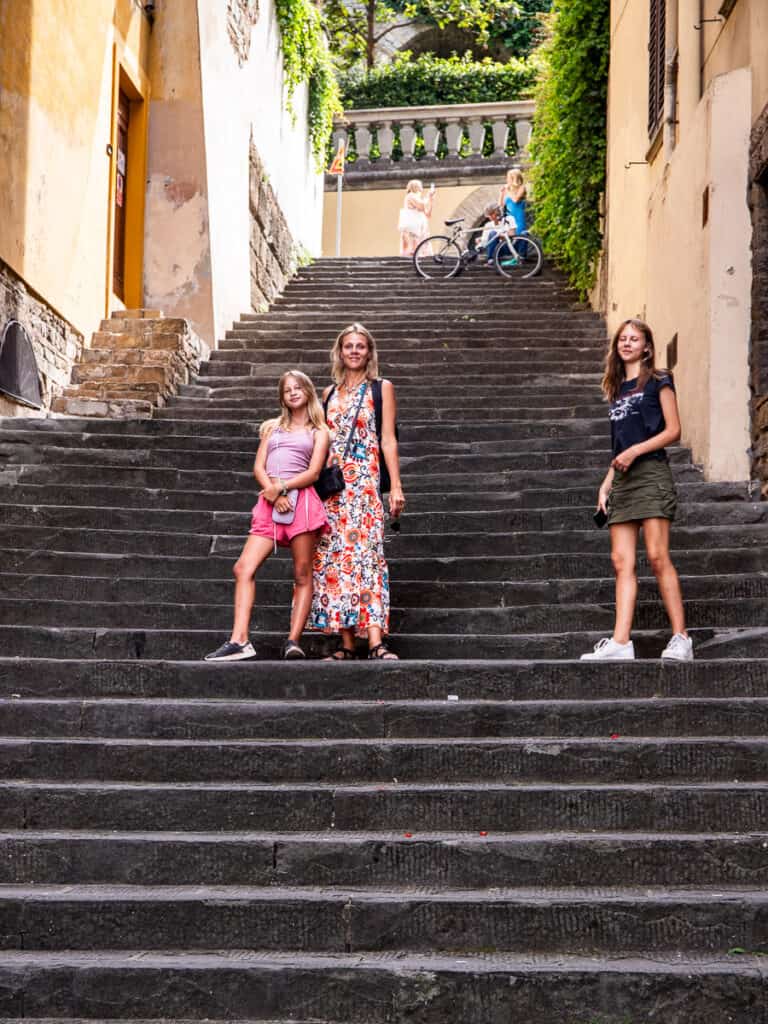
Travel is not just checking of bucket list items – although one cannot miss the magnificence of the Statue of David – it’s also about diving into the heart of local culture through its culinary delights.
If you’re not familiar with Tuscany’s food and wine, then don’t try and do it all on your own. At least carve out a few hours of your time in Florence to join a food walking tour so you can really learn to understand the importance of Tuscan cuisine and wine and how it’s evolved from the food of the poor to one of the most sought-after cuisines in the world!
We had done a previous food tour in Paris and street food tour in Rome, which involved lots of walking and many short food stops.
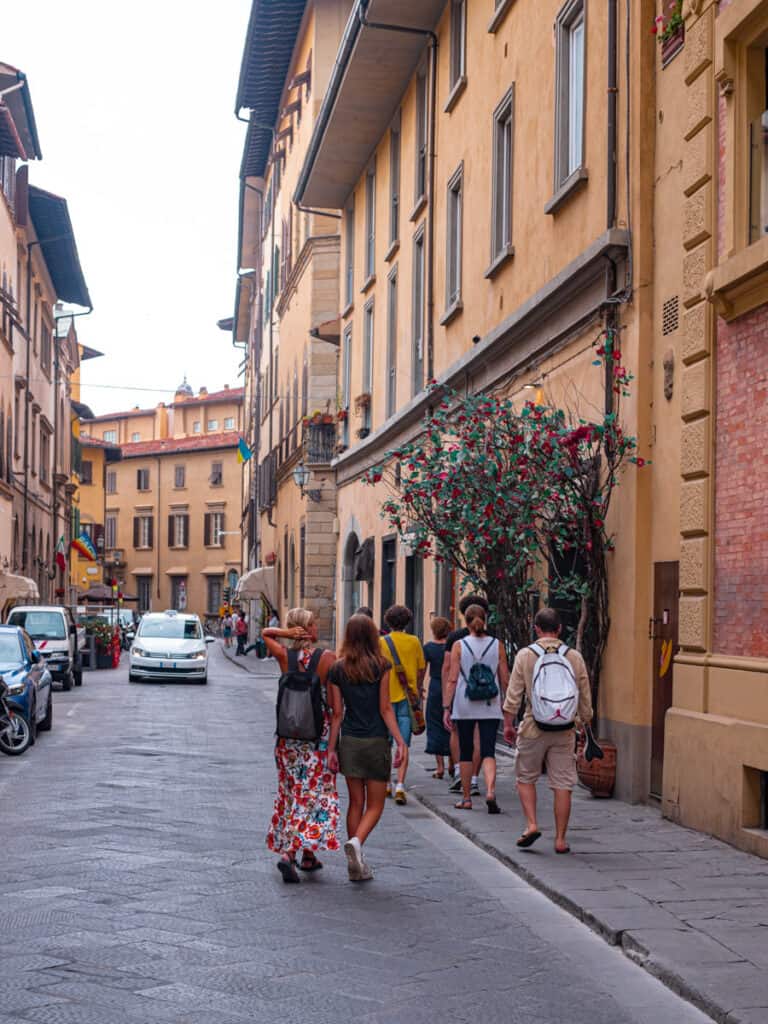
However, the sunset food and wine tour in the Oltrarno neighborhood in Florence was at a more relaxed pace.
We had fewer stops, more time to chat over Florentine steak and glasses of Chianti (which this region of Italy is well-known for) and learned so much from our knowledgeable tour guide.
I loved it just as much as our other food walking tours and I was so glad we had the opportunity to see this side of Florence.
But if you’re thinking about dining out Florentine style but you’re not sure what to expect, this guide will tell you all about our experience on a Tuscan food & wine tour and how you can go about one yourself.
Where To Do A Tuscan Food and Wine Tour? The Oltrarno Neighborhood of Florence
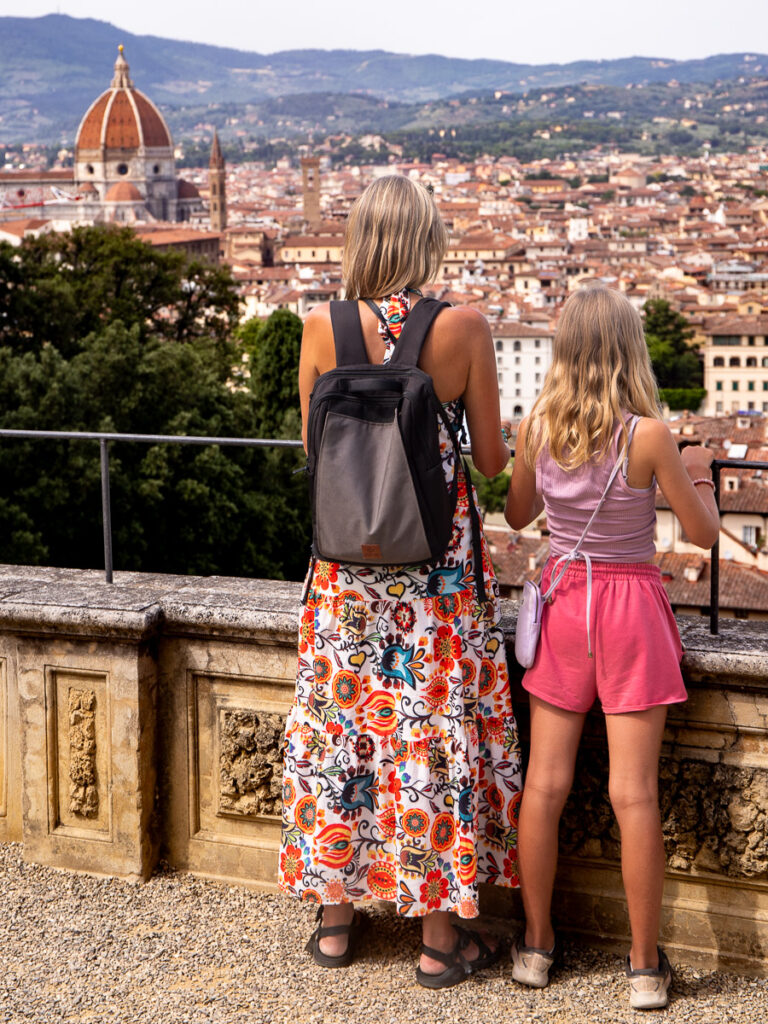
Before we jump into what you can expect from the tour, let’s quickly introduce you to the foodie neighborhod.
The Oltrarno neighborhood is just over the Arno River, south of Florence city center. Its name actually means, “on the other side of the Arno.”

It’s gaining popularity lately as a place to visit on your Florence trip for a more local and quieter experience.
It’s known to be one of Florence’s liveliest and most authentic neighborhoods, a little similar to Trastevere in Rome, although possibly not as busy.
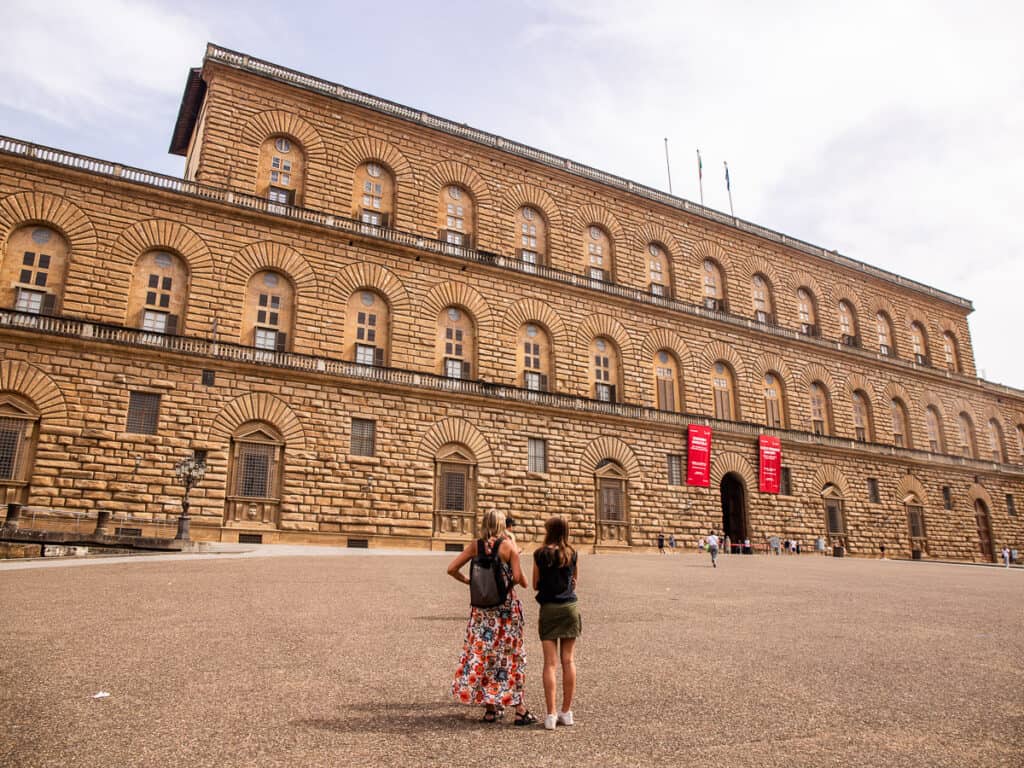
Here you’ll find craft shops, antique stores, tranquil squares, great restaurants, wine bars (enotecas) and other wonderful attractions like Pitti Palace, Boboli Gardens and Villa Bardini. And it’s where many come for spectacular sunset views from Piazzale Michelangelo.
But we weren’t experiencing those Florence attractions on this tour; we were here just for the food and the wine.
What To Expect on a Tuscan Food and Wine Tour
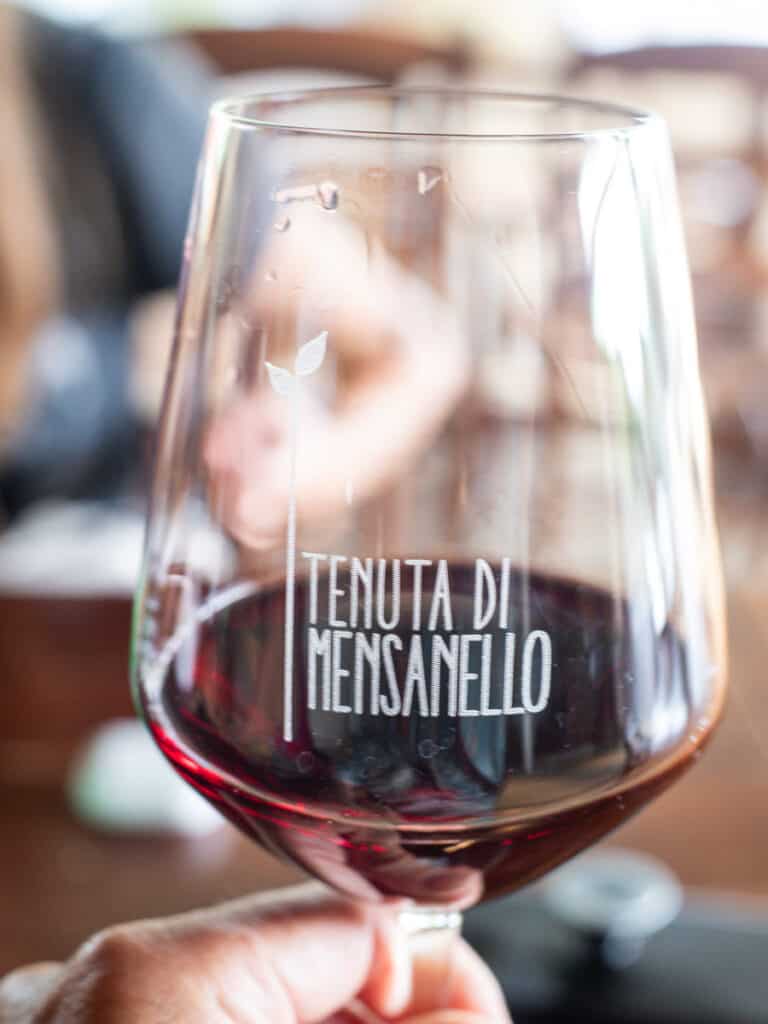
Although we only visited five stops on this food tour, we had over eight food tastings and four drinks on our food and wine tour.
Not only that, but we visited only family-run, small businesses, so we felt good about contributing to the local economy.
We had not only Florentine Steak, but aperitifs and dessert, so our bellies were full come the end.
As well as savouring the delights of Tuscan food and wine, you can also expect to learn a lot about Tuscan eating habits, traditions, history, and where the food and wine comes from.
We didn’t do any winery visits on this tour, but we did sample plenty of wines!
About Our Local Florentine Guide on Food Tour in Florence
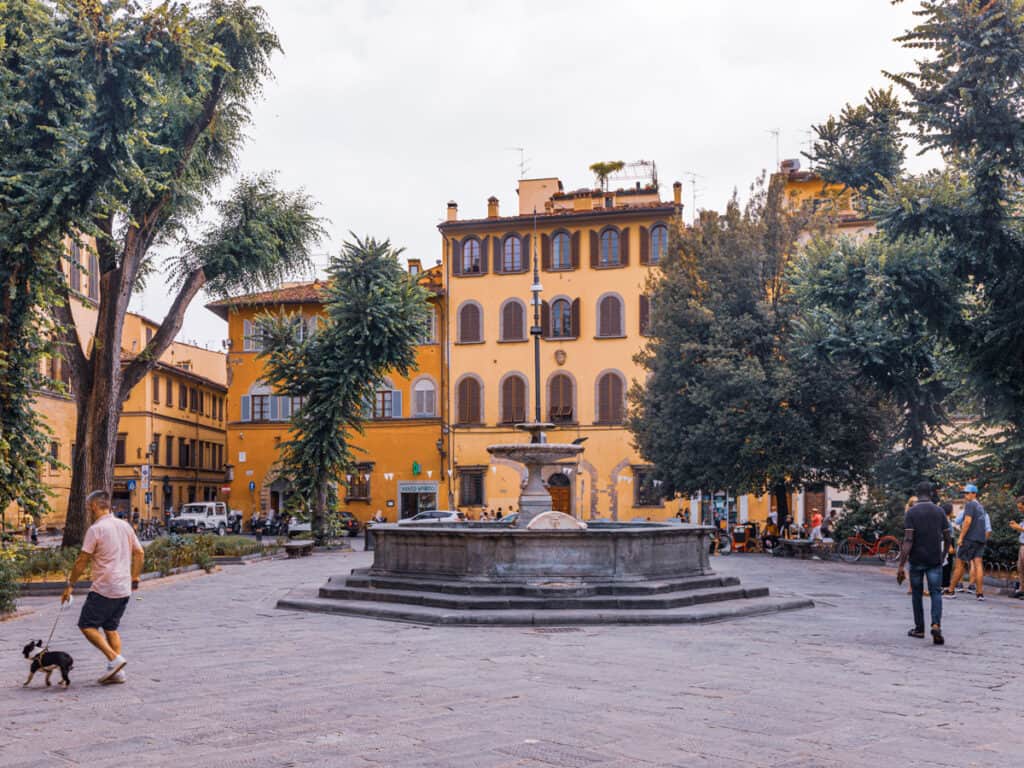
We met with Chiara, our guide who is a born and bred Florentine in the Piazza Santo Spirito, an area popular with locals for socializing during aperitivo hour under the shade of the beautiful church.
Chiara brought together our small group of ten under the one term of “family.”
“Okay family it’s time to eat. Allora family, let me tell you about….“
I loved how one word made us feel like we were a part of something special. I’ve found myself saying it several times to my own family as we continued our travels across Italy.
Chiara has been a guide for several years and understands well the importance of Tuscan food and how it is different to the rest of Italy.
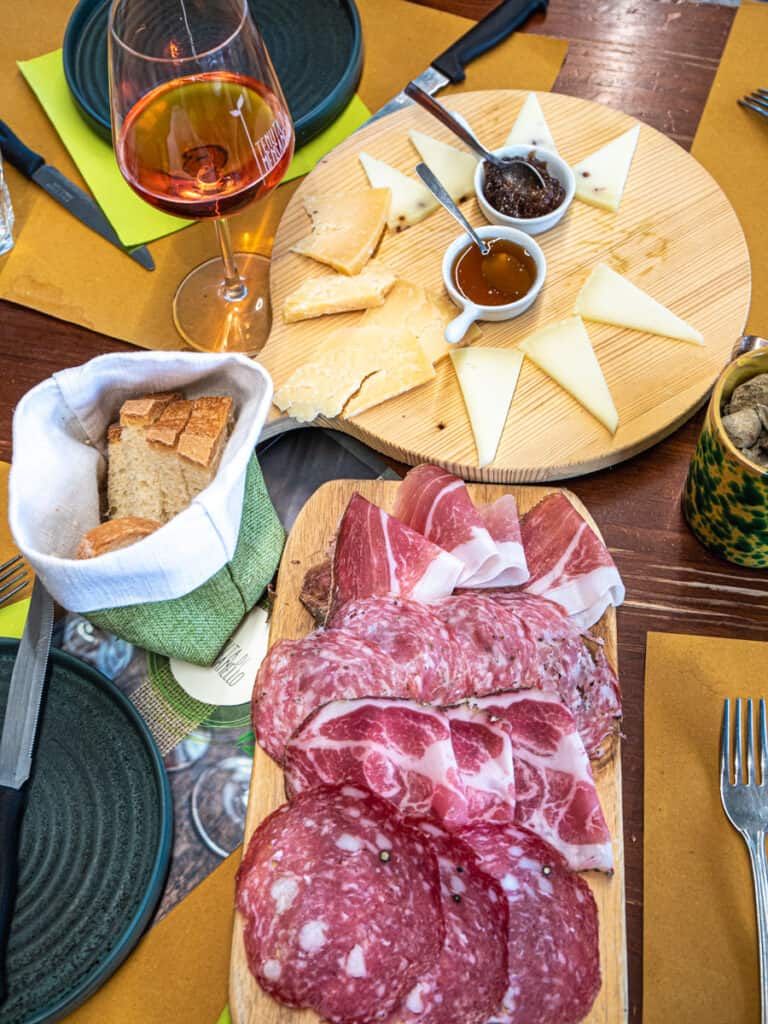
As we learned on our food tour of Rome, there aren’t really national dishes in Italy, as each region has had a long history of their own style of cuisine using regional ingredients long before Italy became the country that it is now.
Chiari also began by having us introduce yourself and share our favorite food (another cool way to help us connect on this more social tour)
We weren’t allowed to say all of it, but all of us had some version of pizza or pasta – none of which come from Tuscany!
Tuscan food is based on bread and meat, not pastas and pizza so common across Italy. (This doesn’t mean you won’t find it in the restaurant in Florence!)
And with that we were ready to begin this unique dinner experience in Florence.
Stops on The Food and Wine Tour in Florence
As is typical of a Devour food tour, we were visiting local family run establishments – five stops including Florentine Steak and enotecas, which is Italian for wine.
1: Wine Tasting and Florentine Focaccias
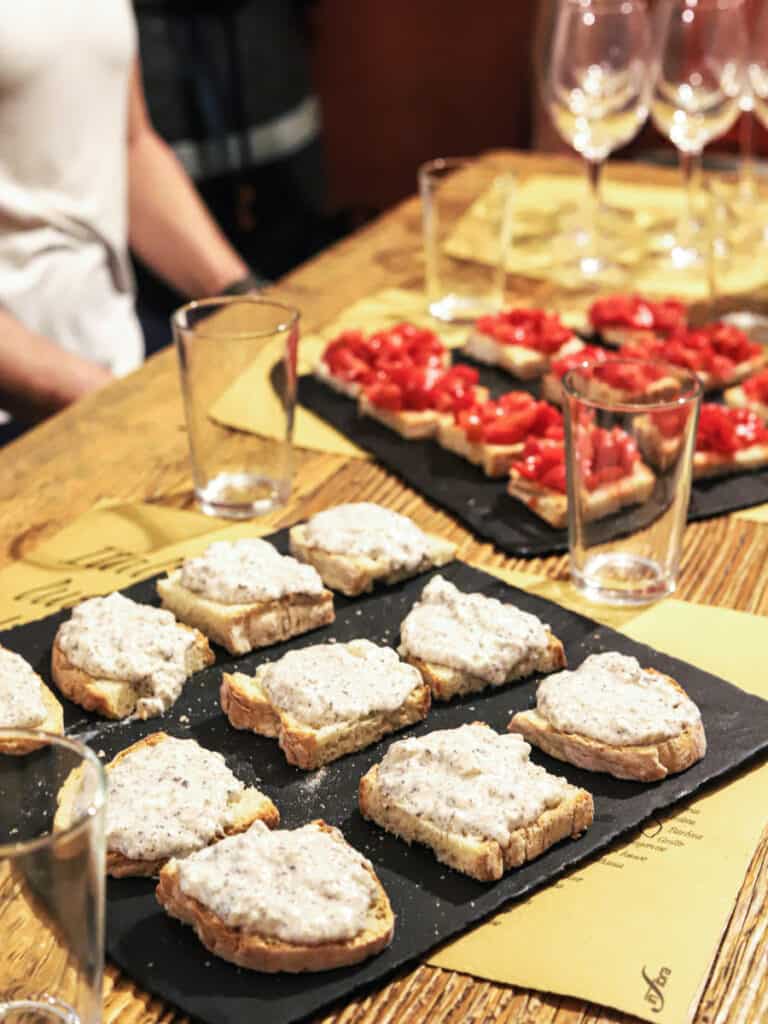
Chiara then moved us to our first stop with a simple, “Andiamo Family” – Let’s go!
We didn’t have far to walk, just around the corner to a small enoteca, or wine bar where we crowded around a small table for Chianti wine and Florentine focaccias topped creamy Stracciatella cheese with truffle; bruschetta; and onion and rosemary.
Chiara was very accommodating to my gluten free requirements, bringing me out gluten free crackers and a plate of pecorino cheese with honey and marmalade.
Our first wine for the tour was a 2020 Le Ginestre Sangiovese.
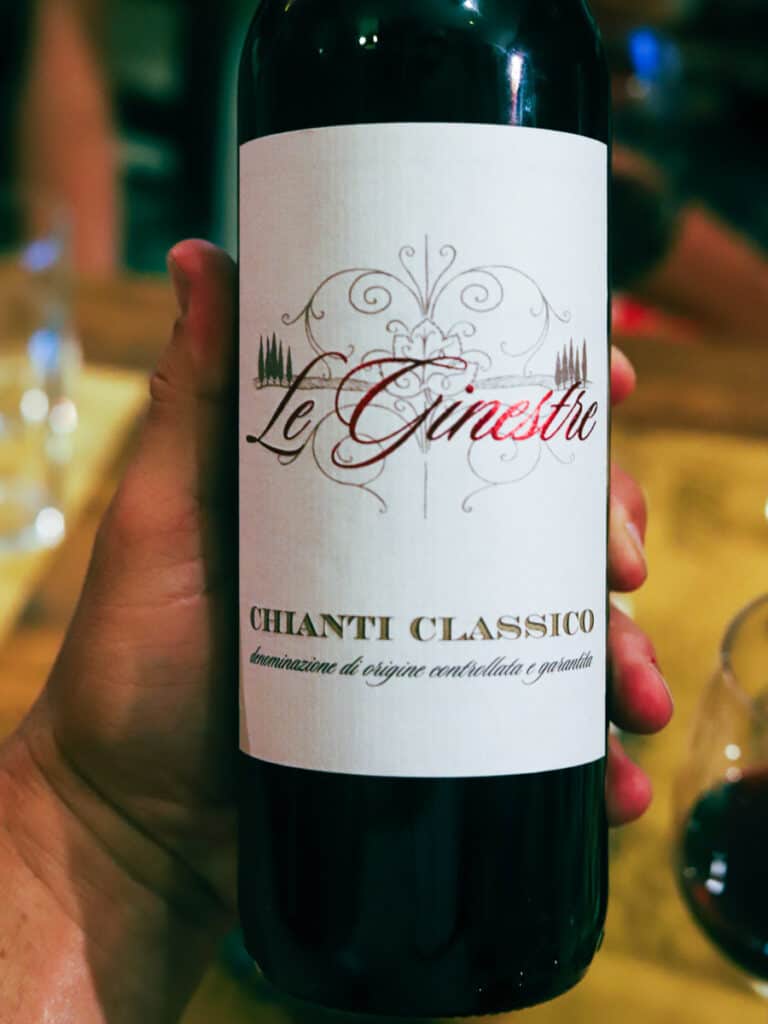
She pointed out the black rooster on the bottle of red wine, which lets you know this is a Chianti classico, which is the original wine from the Tuscany region of Italy between Florence and Siena.
It was declared a wine region in 1716 by Cosimo III de’ Medici, the Grand Duke of Tuscany.
120 years later, five more chianti areas have been declared. For a wine to label itself with the Chianti DOCG it must contain at least 70% Sangiovese grape, along with small percentages of other varieties.
Tow other popular wines from the Tuscany region are Brunello di Montalcino and Vino Nobile di Montepulciano, which are also made from the same grapes, but we stuck with the Chianti on this tour.
As we learned on this first stop on this Tuscany wine tour, wine in Tuscany is part of the meal. You should never drink Sangiovese outside of meal hours.

To demonstrate this Chiara had us first sip the glass of Chianti classico before we ate anything. Then we had another taste after some of the food.
It was quite remarkable how the flavor profile changed, and the wine tasted better with the food. The oil ingredients of the food balance the acidity of the wine so it bites less. Without food your mouth turns dry.
Without realizing it, this is what I noticed eating at our local restaurant, Giorgio Pizza in Raleigh, when I wrote “The ragu elevated the Sangiovese to another level.”
Ciara told us to “Mangia mangia” – eat that plate clean – while she told us more about the history of Florence, including the powerful Medici family of Tuscany, and the importance of extra virgin olive oil and how it’s put on everything except cappuccinos.
Once our plates were cleaned, we stood up for our next stop!
2: The Famous Wine Windows
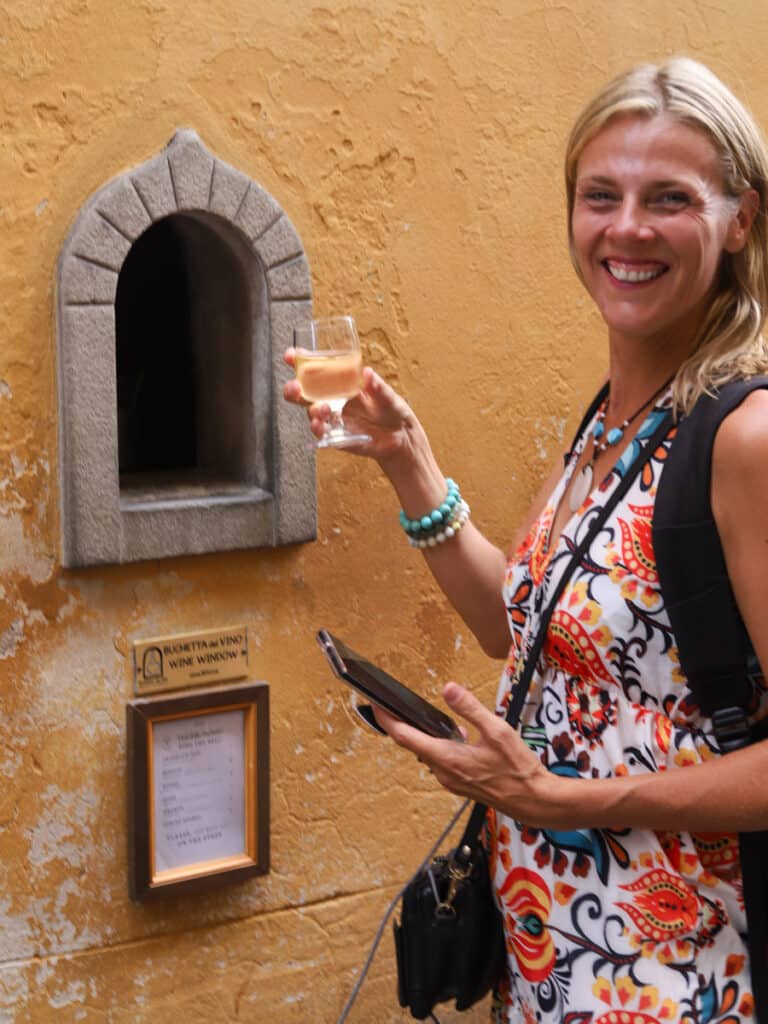
I’m sure if you’ve been searching for things to do in Florence, you may have come across wine windows.
Buchette del vino, wine windows are unique to Florence and now a tourist attraction, possibly made famous by all the people sharing the experience on the Gram.
You may have heard lots of versions of how they came about, including because of the plague – and people still need their wine! Sounds like they would have been a perfect fit for COVID. (In fact, I do think they were used for both reasons mentioned, but not their original intention.)
It all began in the 16th Century with the noble families who had vineyards in the Tuscan countryside. They saved their good wine for family and friends.
The bad vino? They sold them through these palace windows to commoners in Tuscan fiascos, which are pear-shaped flasks covered in straw. These wine windows saved them from having to open up a shop or pay taxes.
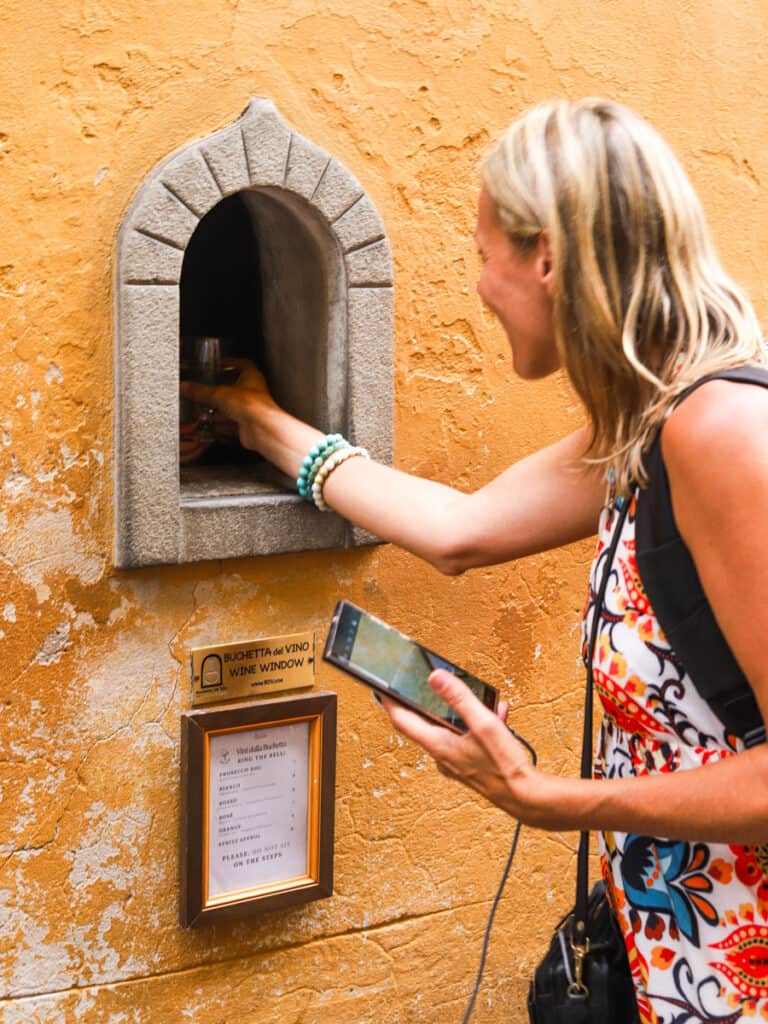
Most wine windows in Florence are about twelve inches high and eight inches wide and with a similar dome shape. There were once about two hundred of them but now there are only a handful operational in Florence. I smell opportunity and wonder why there aren’t more wine windows open for business!
We visited the cute yellow wine window attached to the equally cute and charming Babae restaurant, which was once the palace entry way. There was a lengthy line of tourists, and thankfully being on a guided food tour, you get priority so less waiting time.
It was fun to step up and order, red or white and receive your glass from a hand slowly coming out. The girls got water instead of wine!
We then stood around on the streets soaking up the atmosphere while we chatted more to our fellow travelers, drank a fresh, crisp Tuscan white, and listened to Ciara share more interesting history about the wine windows and noble families.
I’m glad we did this wine window on a tour as I wouldn’t line up for it otherwise – a bit too touristy. We passed by it earlier in the day, around 1pm and there was a line even then.

And Craig and I attempted another wine window near our hotel but left quickly as we couldn’t be bothered lining up that long for a glass of wine. I know I should probably care better, considering we’re travel bloggers, and you know… the gram.
But we’re a little different in that we don’t care more about enjoying the present moment than a chance to go viral!! Basically, great at life, not so much at Instagram!!
And I really don’t want to increase the waiting time for people behind me by hogging the limelight to get a gramworthy shot.
3: Wine And Cured Meats
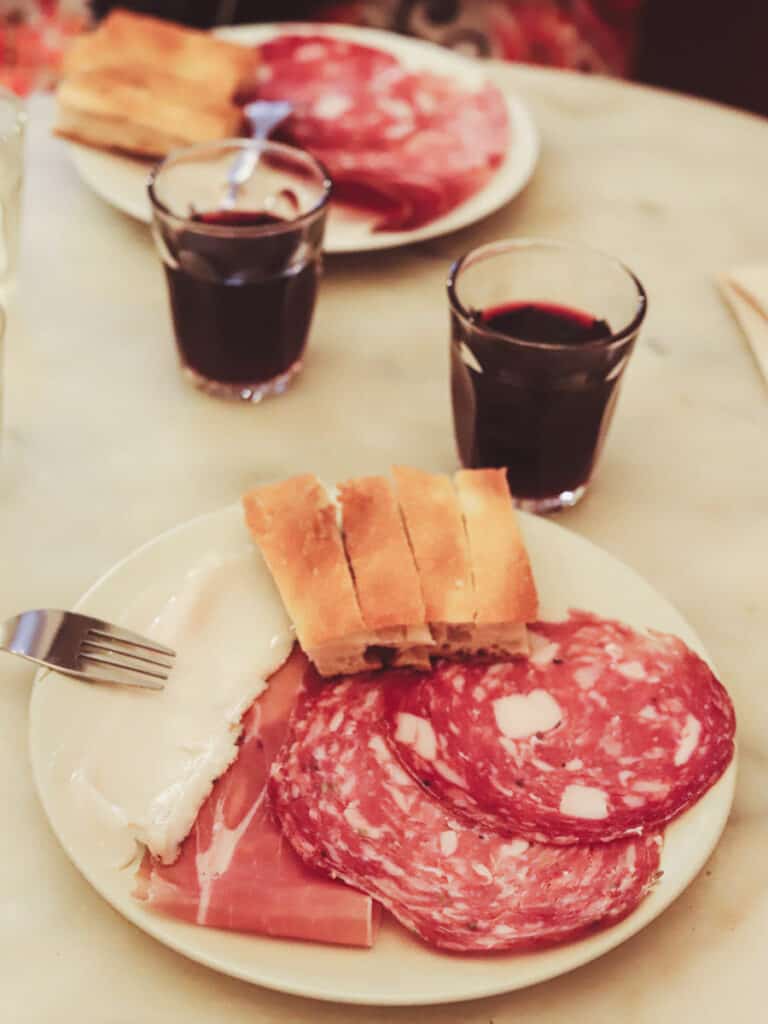
As it’s a food and wine tour, it makes sense our next stop was another family-owned small enoteca or wineries.
Again, we were following Tuscan rules by drinking wine with our food. This time it was a plate of cured meats.
We had Tuscan salami and prosciutto, which was saltier than others, Tuscan salami with black pepper seeds and Tuscan salami with fennel seeds.
Then an interesting new taste white salami, or Lardo, which is pork fat seasoned with black pepper, juniper sage, and rosemary and six months seasoned so it comes out softer and nicer.
I’m not sure how I felt about this one. I enjoyed trying it, but not sure I’d eat a lot of it.
At this stop on our Florence food tour, we had a glass of white wine which is refreshing for cheers – Salute in Italian, which means good health for yourself and family.
Followed by a 100% Sangiovese grown in the chianti region, but aged less than one year. To be a classico, it must be aged for at least one year.
This Sangiovese is even sharper than the other if drunk on its own, and this Tuscan red tastes better with cured meats.
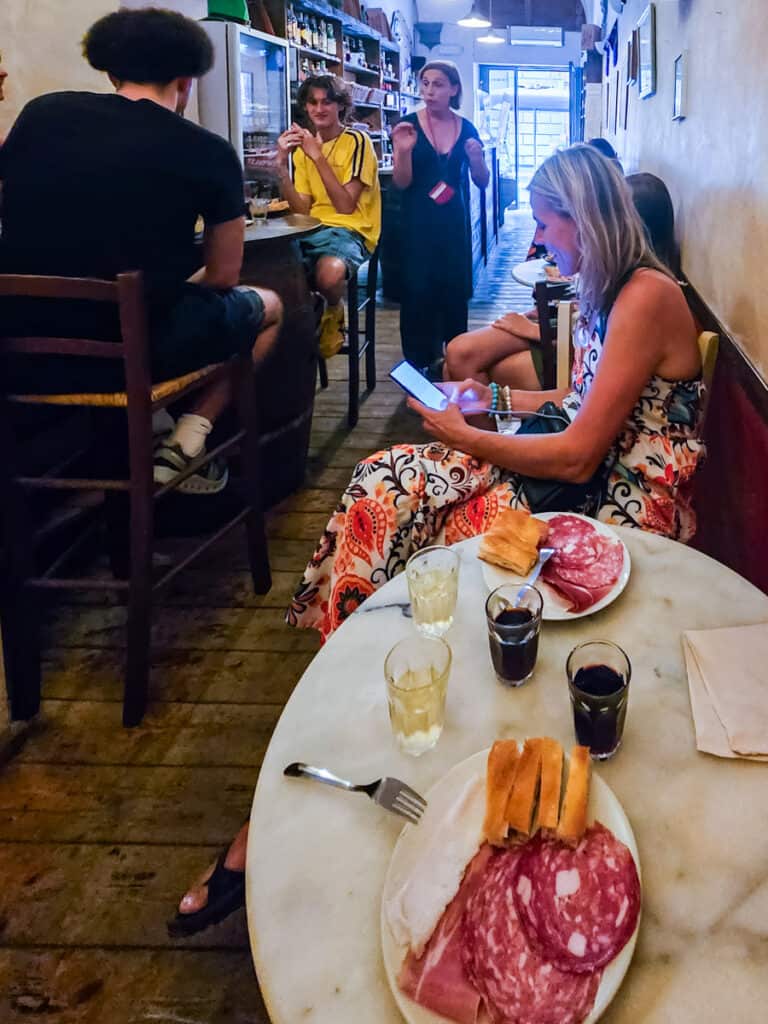
For this wine tasting exercise, Chiara told us not to eat fennel salami before tasting the wine as fennel seeds change your palette.
Serving fennel first was once a sneaky trick used to disguise bad tasting wine, as you won’t taste it!!
But now the secret is out.
That’s a way for you to stomach any bad red wine you may get as a gift or accidentally buy at the store!
As we ate, Chiara shared more about this formerly working-class neighborhood we were sitting in and an exciting event happening the weekend following our visit.
Florence was once divided into four church districts. each represented by a color, and every year they districts play each other in a local sport called Calcio Storico.
This unusual football match is a mix of soccer, wrestling, American football and rugby.
The final is always played on June 24, Florence’s patron saint’s feast day for St John the Baptist and this year, red (Chiara’s team) were playing blue.
The game originated in the 16th century and is recreated every year including the dirt floor arena in front of Santa Croce.
This is one of the main events of the year in Florence and crowds come out to watch the game, and teams’ parade around in historical costumes and fireworks at night.
4: Florentine Steak & Vin Santo at Trattoria BBQ
Apart from the wine, we were most looking forward to eating Florentine steak. We were thrilled when we saw it was on the menu. Florentine steak can be expensive, so I was grateful to try it on this food tour!
Chiara led us to the beautiful outdoor seating at Trattoria BBQ. The sun was starting to go down so temperatures were ideal for sitting outside.
Passionate Florentine, Chiara made sure to let us know the etiquette and laws around cooking and eating Florentine Steak.
Like French pastries and wine, this is serious business.
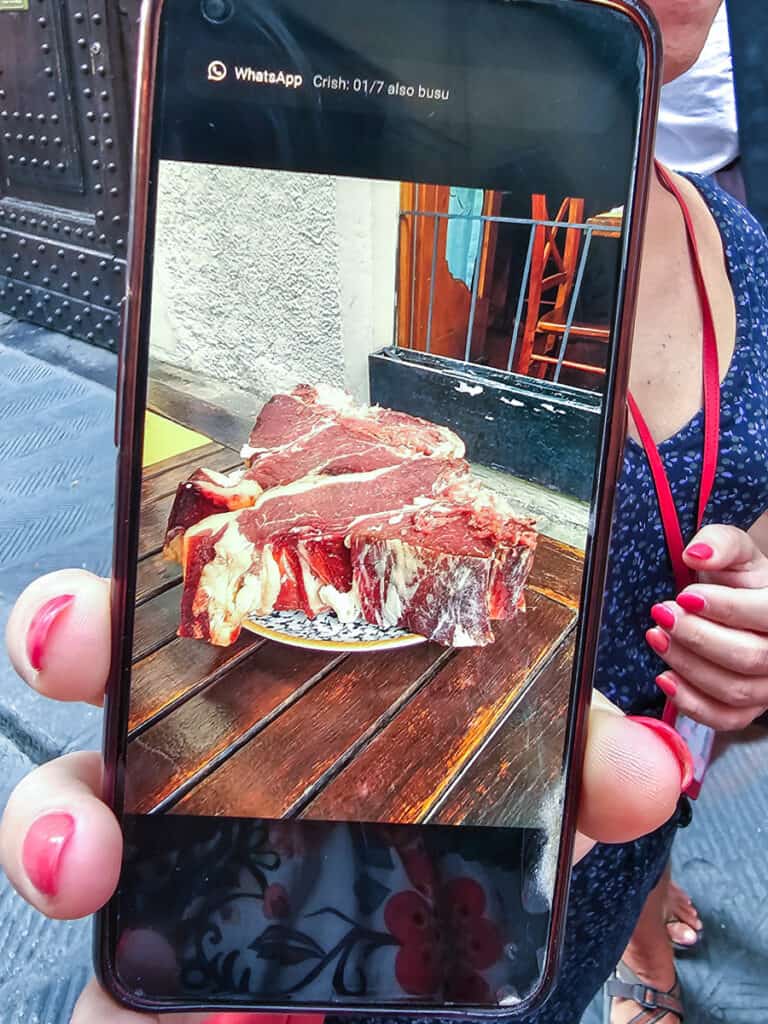
Florentine steak is a T-Bone steak and by law must be 3 – 4 fingers thick and cooked rare or medium rare to about 55°C / 135°F in the middle.
You must not spoil the steak by eating any starters and show up to the table hungry. You can have sides but make them simple. Usually, you’ll share the steak with another person, but if not, drop the sides.
Season the steak only with salt and pepper and cook for one minute on the bottom and top, 6 or 7 minutes on side and then 1 minute standing on top to let the juices flow.

Absolutely no sauces. Chiari feels visibly sick thinking about ketchup on Florentine steak and she asks that you do not offend Florentines by not following her instructions.
I was happy to let the steak do the flavor talking!
Chiara gave us a demonstration of how to eat it by drizzling olive oil on the plate and adding salt and pepper to it. Then you take your pieces of steak and dip it in.
You can pair the steak with Tuscan bread, and most importantly, red wine. Even better if served in a Tuscan fiasco.
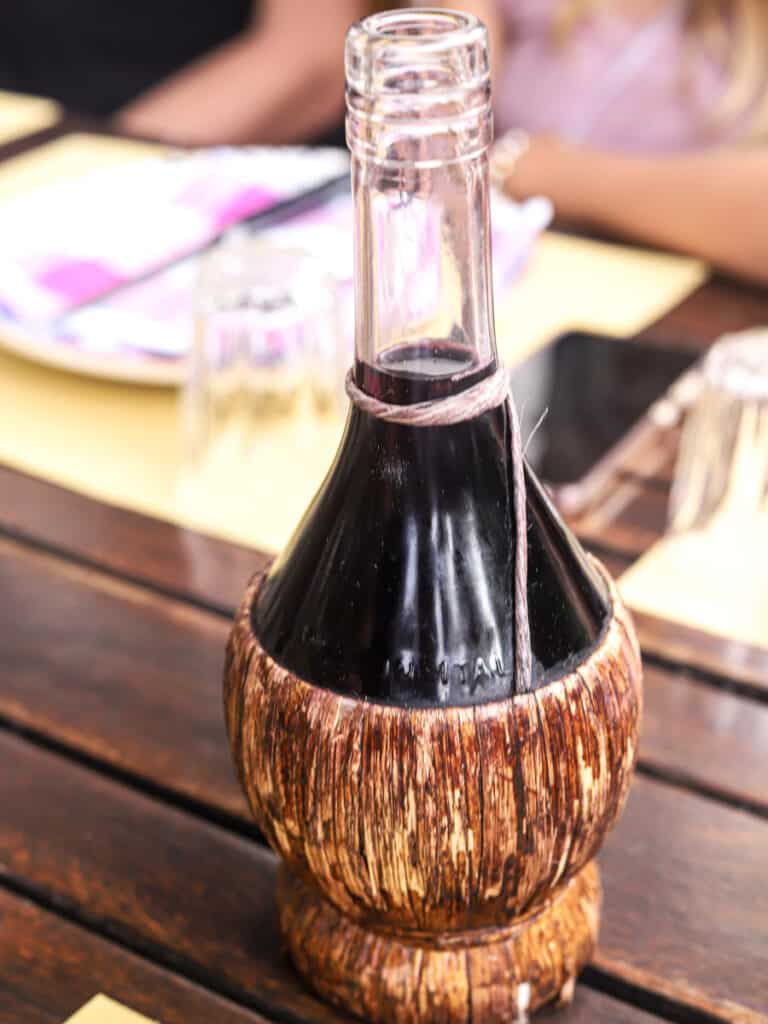
Sitting around the table eating delicious Florentine steak, drinking Tuscan red wine, and chatting about life, travel, and more with the other guests on the tour was a highlight.
Chiara then bought out a surprise for our group:
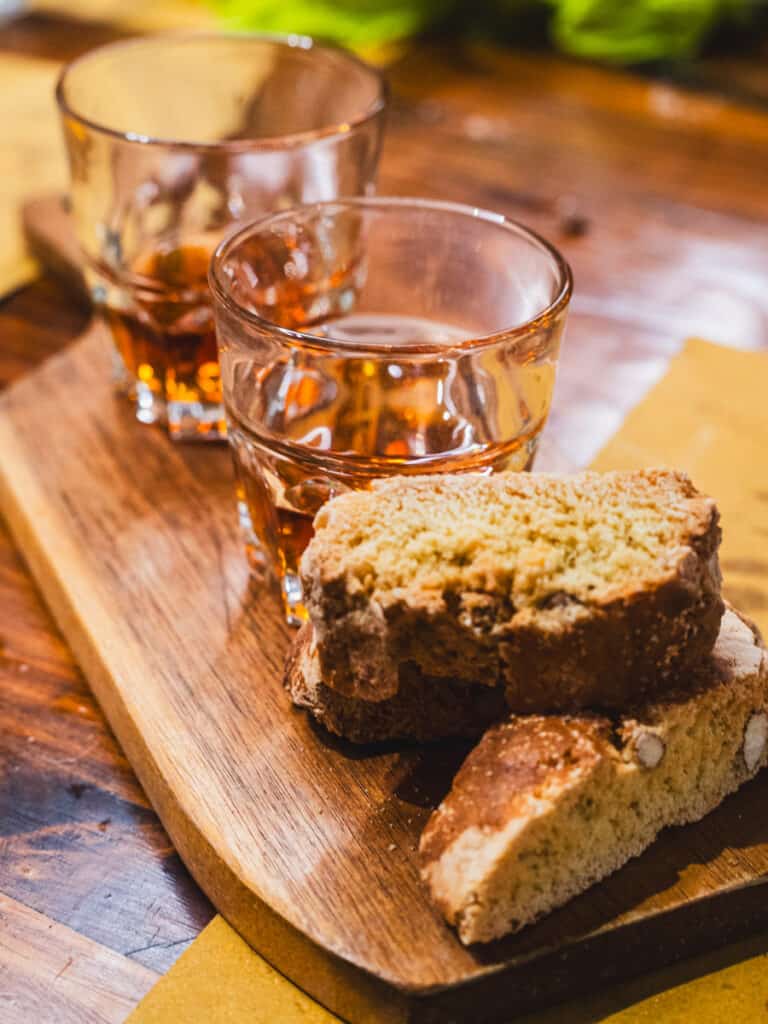
A glass of Vin Santo paired with an almond -studded biscotti and a small glass of Vin Santo. Craig and I had some of this dessert wine at our Tuscan farm stay the evening before and I was not jumping out of my skin to have more.
On their own, both are pretty gross – the wine super sweet and the bread biscotti dry and hard.
But together it’s a miraculous example of how two uglies can become beautiful when married at the same time.
I didn’t try the sweet wine with the biscotti during our farm stay. This time, I decided to try just a little bit with the biscotti to see what this was really about (I am gluten free so a little was all I could spare).
I really did enjoy how sweetly moist the biscotti came after a few seconds dipped in the sweet dessert wine. It was actually quite moorish and I had to stop myself from continually dipping.
This is a traditional Tuscan dessert and known as the last drink of the meal.
Alora. So with that we moved to end the food tour in another Tuscan way.
5: Original Gelato at Gelateria Artigianale La Sorbettiera
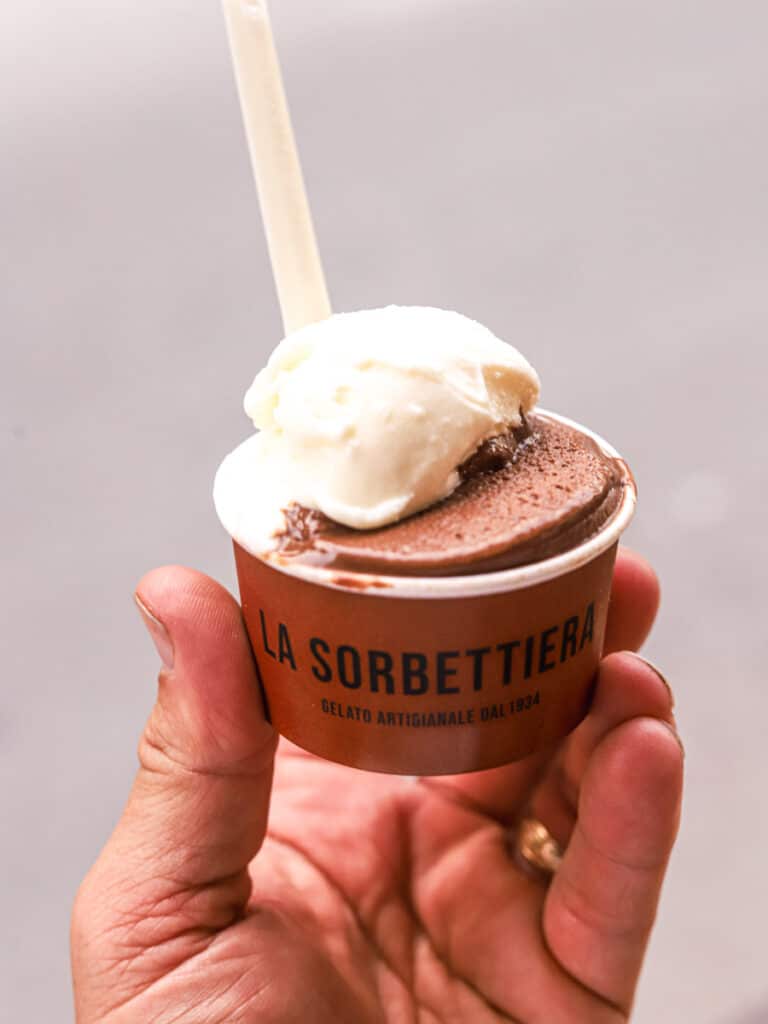
Gelato did originate in Florence during the 1500s Italian Renaissance. Gelato was officially developed by famous artist and architect Bernardo Buontalenti although some will claim alchemist Cosimo Ruggieri created the first-ever gelato (fior di latte) at the court of Catherine de’ Medici as part of a courtly cooking contest.
Nothing like a good story passed through centuries to change a little!
We were now experts on finding good gelato, thanks to the tips we received on our street food tour of Rome.
Earlier in the day, I had eaten the best gelato of my life, coincidentally also from Oltrarno. A month later I can still taste those melting bits of hazelnut chocolate inside the Stracciatella.
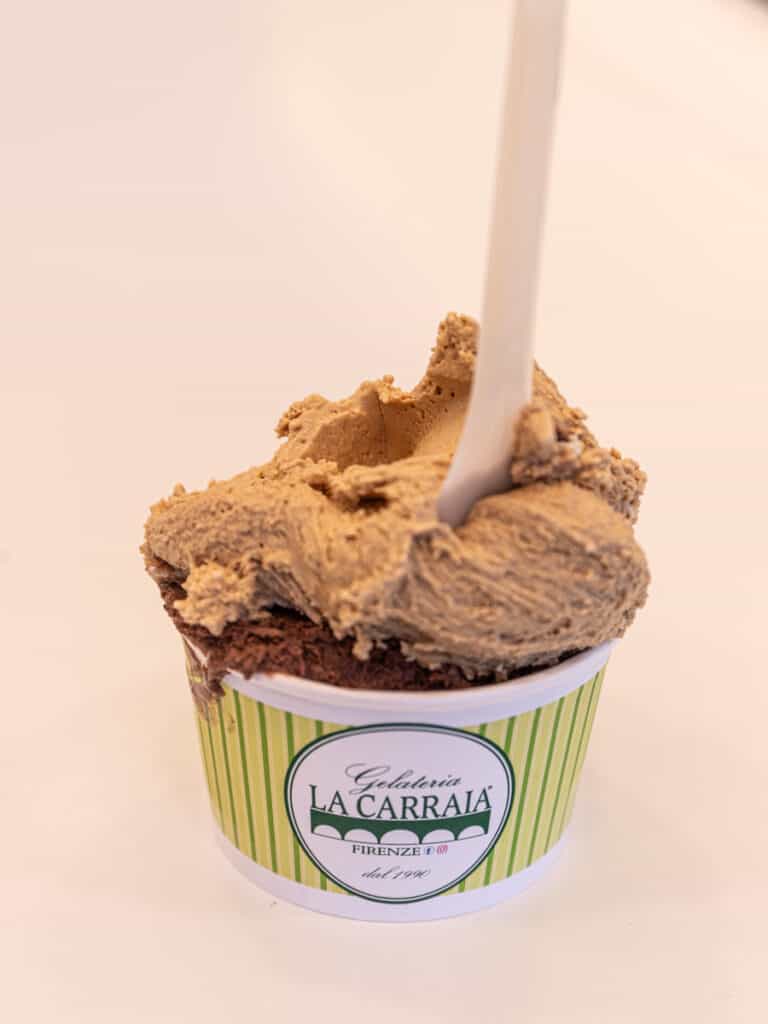
Thank God for Florence.
Chiara told us about 95% of the gelatos in Florence are good and the real deal.
Gelateria Artigianale La Sorbettiera was founded in 2007. They continue to make authentic artisanal gelato paying attention to tradition but also emerging trends AND the dietary requirements of their customers.
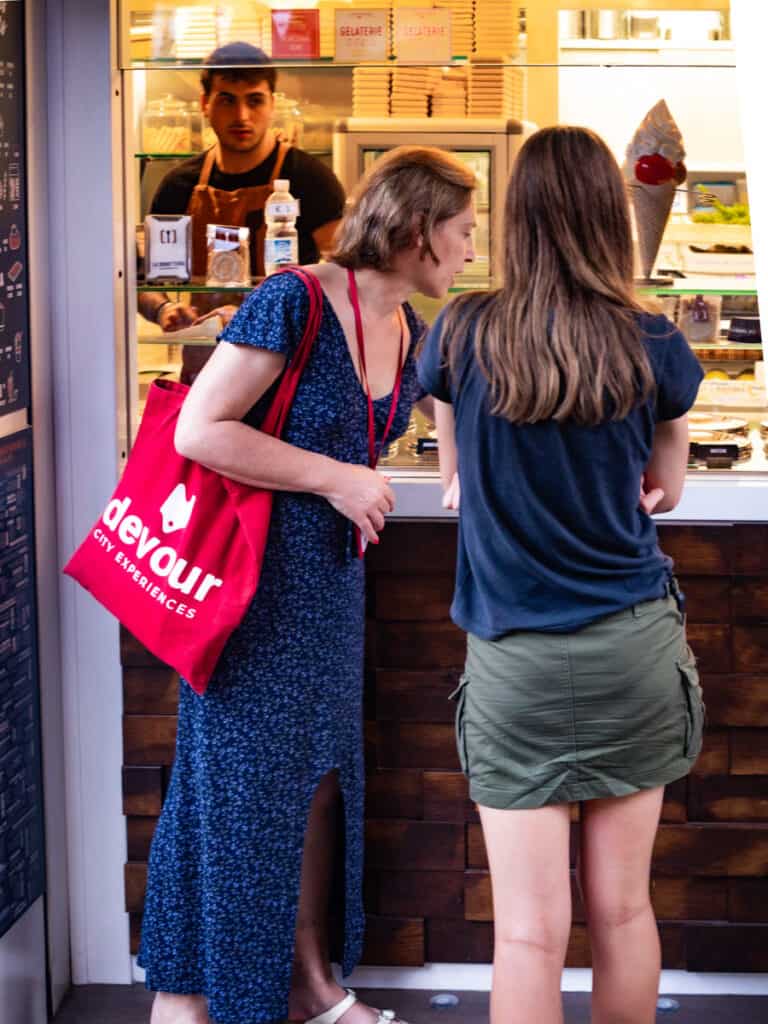
Chiara patiently told us all the flavors, as they were written in Italian, and helped us choose any combination of two flavors.
At this gelateria you can taste what was the original recipe for gelato. It’s creamy and delicious, kind of like vanilla but without the vanilla. You’ll understand when you try it.
What a sweet end to an exceptional food and wine tour in Florence.
FAQs About Florence Food & Wine Tours

Below is what people ask us about food tours in Florence…
Is this Food and Wine Tour in Florence suitable for kids?
Well, ours joined us on our food and wine tour in Oltrarno! While all the stops involved wine, kids can have soda or juice. And each stop comes with food!
I think people from good food cultures like Italy and France, who are so seriously dedicated and passionate about good food, were raised embracing food culture like we experienced on this tour.
So that in itself is a positive reason for taking kids on a food tour. Especially since they are growing up in a fast food, eat-on-the-run kinda lifestyle, giving them the first-hand experience of slowing down to eat with a group of people and thinking about how food should be eaten and paired with what drinks is very valuable.
I do recommend this tour for older kids. There was another family with a 17-year-old, he was loving it.
It just depends on the ages and food-interest level of your kids. You may not want to spend that money a food and wine tour with kids. We joined the tour so we could write about it and share so our kids obviously came along!
Is this suitable for those with dietary requirements?
As mentioned, I’m gluten free and could eat almost everything on the food tour. What I couldn’t was substituted for gluten free. If you have celiacs disease, you may not want to risk it. The tour is also adaptable for vegetarians and dairy free, but probably not for vegans. Note any requirements when booking. It was also one of the first things Chiara asked us at the start of the tour!
Where does this food and wine tour of Florence meet?
At the beautiful Piazza Santo Spirito by the statue of Cosimo Ridolfi in Oltrarno at 4:45pm Why not come earlier to soak up the atmosphere here? It’s also close to Pittie Plaza and the Boboli Gardens if you want to visit them before the tour. We did!
Do you visit the wine cellars on a food and wine tour in Tuscany?
No, you don’t get to see the cellars or where the wine is produced on a food and wine tour of Tuscany, you just visit some of the best wineries, wine bars and restaurants where you can try the local wines.
In Conclusion
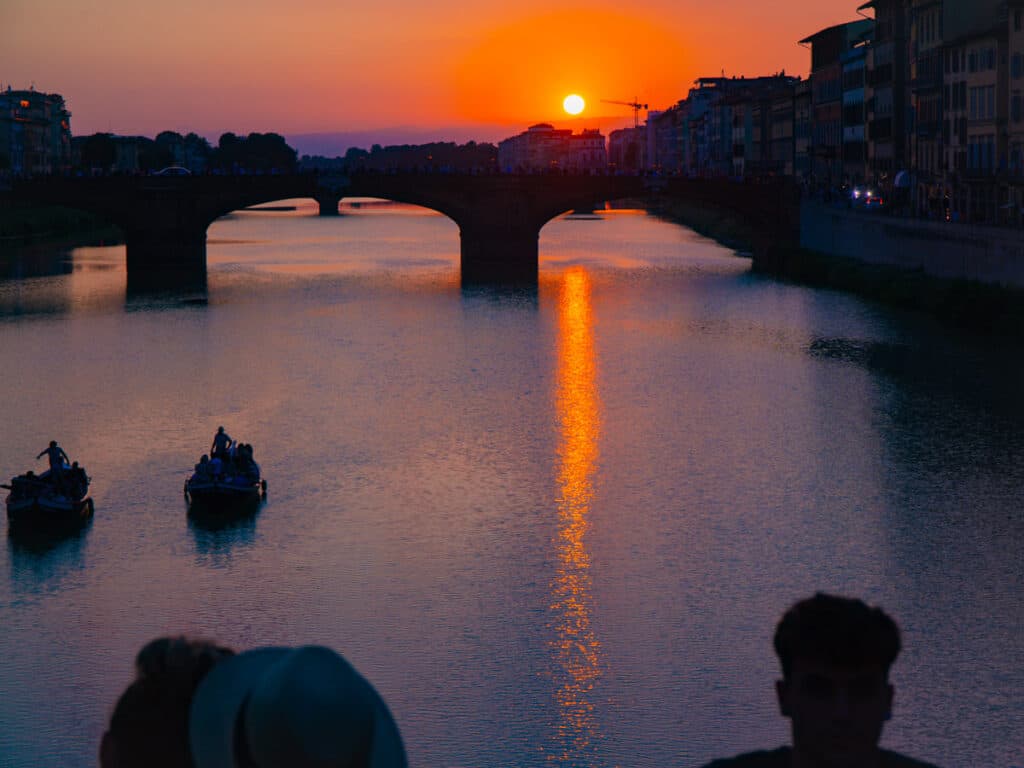
Because of this tour I was able to experience the deliciousness of Florentine steak, understand why I’ve not loved drinking Chianti before (it’s all about the missing food), and appreciate the sweet goodness of biscotti dipped in Vin Santo.
As always with Devour food tours, this was made even better by a friendly, informative local guide who shared much about Florentine history and culture.
I love the focus of these tours on local and tradition. It’s where you’ll find the best flavors and the best stories.
As the sun was setting our small group dispersed, some going for a walk, some going home and others going to nearby rooftop bars for tangerine sky views over the lush landscapes. I don’t think any of us were planning to eat more food.
We walked along the river enjoying the setting home before dropping the girls off to our hotel (they were ready for Facetime with friends) and Craig and I went around the corner for one more glass of Tuscan red in yet another Enoteca.
I’m getting quite addicted to the Italian lifestyle: espressos, cappuccinos, aperitivos, and gelato to last the whole day! You may also want to see what other top things there are to do in Florence!
[ad_2]
Source link
